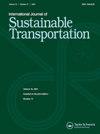评估加拿大多伦多自行车发展的潜力
IF 3.1
3区 工程技术
Q2 ENVIRONMENTAL STUDIES
International Journal of Sustainable Transportation
Pub Date : 2023-12-01
DOI:10.1080/15568318.2023.2196264
引用次数: 0
摘要
本文章由计算机程序翻译,如有差异,请以英文原文为准。
Assessing the potential of cycling growth in Toronto, Canada
Cycling is seen as a desirable modal choice due to the environmental, economic and social benefits to individuals and cities. While North American cities have expanded their targeted infrastructure and programs, cycling still is a marginal mode compared to modal shares observed in western Europe. In an effort to promote a more sustainable transport future, the City of Toronto has highlighted two key policy objectives in the City’s Official Plan for 2050: (i) to ensure that all residents are within one kilometer of a designated cycling route, and (ii) 75% of trips under 5 km are walked or cycled. This paper evaluates the potential for cycling in Toronto considering different cycling vehicles, areas, trip purposes and demographics, and how these change given the presence of cycling infrastructure. Using travel survey data and routing software, we propose a method to analyze the Trip Completion Potential (TCP) of cycling, defined as the rate of completable trips within a 30-minute travel time cutoff and the changes in value given different Levels of Traffic Stress (LTS). Overall, our analysis found that cycling can be a viable transport option for short and medium-length trips for many individuals and trip purposes. However, both the urban form and provision of a convenient cycling network play a vital role, especially in suburban areas, as seen in the decrease in TCP of cycling at different LTS levels. We conclude our analysis by proposing some key guidelines to achieve the objectives defined by the City of Toronto in an equitable manner.
求助全文
通过发布文献求助,成功后即可免费获取论文全文。
去求助
来源期刊
CiteScore
8.90
自引率
2.60%
发文量
56
期刊介绍:
The International Journal of Sustainable Transportation provides a discussion forum for the exchange of new and innovative ideas on sustainable transportation research in the context of environmental, economical, social, and engineering aspects, as well as current and future interactions of transportation systems and other urban subsystems. The scope includes the examination of overall sustainability of any transportation system, including its infrastructure, vehicle, operation, and maintenance; the integration of social science disciplines, engineering, and information technology with transportation; the understanding of the comparative aspects of different transportation systems from a global perspective; qualitative and quantitative transportation studies; and case studies, surveys, and expository papers in an international or local context. Equal emphasis is placed on the problems of sustainable transportation that are associated with passenger and freight transportation modes in both industrialized and non-industrialized areas. All submitted manuscripts are subject to initial evaluation by the Editors and, if found suitable for further consideration, to peer review by independent, anonymous expert reviewers. All peer review is single-blind. Submissions are made online via ScholarOne Manuscripts.

 求助内容:
求助内容: 应助结果提醒方式:
应助结果提醒方式:


